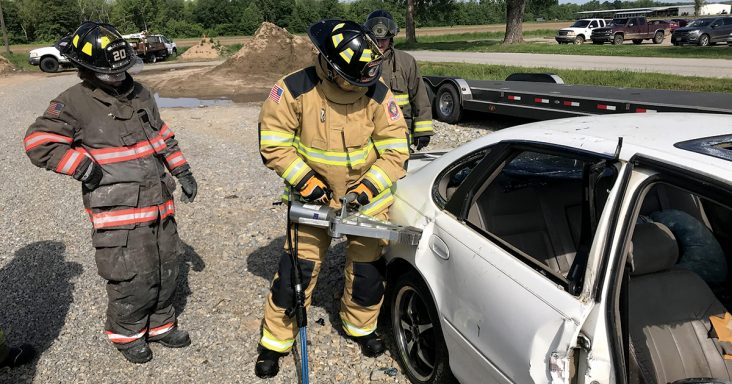Black River Technical College one of few fire science programs in state
by September 9, 2020 11:00 am 616 views

Alan Haskins has a lot of fond memories from his youth, but among his most favorite were attending volunteer firefighting meetings with his father, Jackie. His father was a volunteer assistant fire chief for the Ash Flat Fire Department and he also worked as a firefighter in the Arkansas Forestry Service.
It encouraged Haskins to follow a career in the same vocation. He started as a firefighter in Walnut Ridge in 1993, and by the time he left the department in 2010 he was the city’s fire chief. Haskins, who has served as the director of the Black River Technical College Fire Science program for the past 10 years, said there is a need for a new generation of firefighters. He told Talk Business & Politics the methodologies for tackling fires have changed a lot over the past three decades.
“There’s a lot of science involved … it’s much more about science now,” Haskins said. “The days of just kicking down a door and throwing water on a fire are gone.”
Home and other structure fires in the U.S. are costly and deadly, according to the National Fire Protection Association. There are an estimated 354,400 home structure fires per year that cause about $6.9 billion in direct property damages, the NFPA reported. Those fires kill 2,560 Americans per year. About 80% of all fire deaths come from home fires.
The causes can range from heating and lighting equipment, electrical distribution, the use of smoking materials such as cigarettes or intentional fire setting. The top cause of home structure fires and deaths are those that are started by people cooking. While injuries are caused by fires, most of the deaths are attributed to smoke inhalation.
BRTC offers one of the few programs in the state to train those who want to pursue a firefighting career. The college offers a 13-week program that puts students on their way toward state certification, Haskins said. The traditional program requires 23 credit hours, but this fast-track program allows them to get into the workforce quicker.
“We’re trying to get them certified faster,” he said. “They still end up getting their 23 hours.”
There are six participants in the BRTC Fire Science program, but Haskins said he hopes to increase that number significantly. The ideal class size would be about 25 students, he said.
A few years ago, the state dropped the age for a certificated firefighter from 21 to 18 and that has broadened the pool of potential applicants, Haskins said. Individual departments have the option of accepting firefighters that are below the age of 21, he added.
Students are introduced to a broad range of training. They are taught the fundamentals of fighting fires and how fire science works. Students are taught how to use their equipment such as their turnout gear.
In recent years, fire departments have been required to assist in just about every kind of emergency imaginable, Haskins said. Students learn fundamental first aid techniques such as CPR. Firefighters have to learn how to deal with hazmat-related disasters and even have to coordinate with other agencies during potential terrorist attacks.
“There’s a lot of gear involved … we teach so much science now,” he said.
While it’s a lot of work, there are perks to being a firefighter, he said. The first perk is that firefighters help people in their worst moments in life, which can be comforting and rewarding, he said. Another is the schedule.
Firefighters typically work 24-hour shifts, but it equates to only about 11 days per month, and that doesn’t include off time for vacation and sick days. Many firefighters have second jobs so they can maximize their incomes, he added. Insurance and retirement plans are also perks. The average Arkansas firefighter makes an annual salary of about $36,000, according to Business Insider.
There may be several reasons to become a firefighter, but there are shortages nationwide. The federal government had to hire 8% fewer than its target for federal firefighters in 2019 and there are reported shortages of volunteer firefighters nationwide.
Getting enough students into the fire science program is a challenge, but Haskins said they developed new ways to spark interest. At the Lawrence County School District, high school fire science classes are part of the curriculum. Students can start training in high school and receive credit, which is very helpful in ushering them into the college level program.
This semester there are up to 15 high school students in Haskins’ program.
Females have not typically chosen firefighting as a career path, but in recent years more have been interested, he said. Many already work as volunteers, and Haskins said several of his former female students have been hired at other departments. He has one female in his program right now.
Those future firefighters will be needed in the coming years, he said. A lot of firefighters in Jonesboro and Paragould are retiring. Labor shortages are projected in all sectors in the coming years, but fire protection is a key for business and homeowners. It lowers insurance costs and it helps to protect the community, Haskins added.
“The jobs will be there … we just have to get those kids interested at an early age,” he said.
